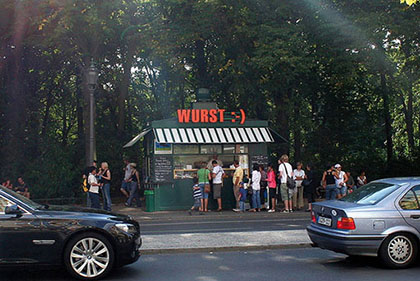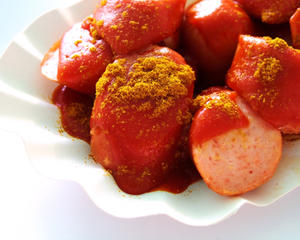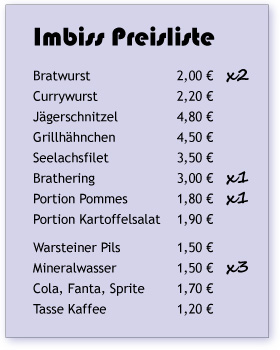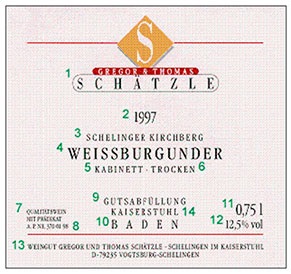7 Snack foods
Culture: Imbissbuden
You can buy different sausages, such as Bockwurst, Bratwurst and Currywurst, throughout the German-speaking countries in snack bars (Imbissbuden), and there are over 40 different regional varieties of Bockwurst alone. The sausages may be served in a bread roll (Brötchen), with potato salad (Kartoffelsalat), Sauerkraut or chips (Pommes frites or Fritten), and of course a little mustard (Senf).
Snack bars may be located in a mobile stand, a kiosk or a small shop, and many take the form of a Stehcafé or Stehimbiss, which provides no seating, just a few tall tables that customers can stand at while they eat their snacks. The Austrian Würstlstand pictured here is in Vienna (Wien).
- Vokabeln
- ihr zu Ehren in its honour
hat … erfunden invented
hat … angeboten offered
nicht nur not only
Activity 24
This is a text about two of the most popular snacks in Germany: the Currywurst and the Döner. You do not have to understand every word but try to get the gist of the two paragraphs. Then decide whether the six statements beneath are richtig (true) or falsch (false) according to the text.
Täglich lockt die Currywurst
Die Berliner Imbiss-Spezialität gibt es in vielen Variationen. In Berlin gibt es sogar ein Museum ihr zu Ehren: die „Currywurst“. Man sagt, Herta Heuwer hat die Currywurst am 4. September 1949 erfunden. An ihrem Imbissstand an der Ecke Kant-/Kaiser-Friedrich-Straße in Charlottenburg hat sie gebratene Brühwurst mit einer Soße aus Tomatenmark, Currypulver, Worcestershiresauce und weiteren Zutaten angeboten. Heute gibt es viele traditionelle Imbisse, wo man die Spezialität kaufen kann.
Döner + Falafel: Der Berliner Kultsnack
Was ist fast noch typischer für Berlin als die Currywurst? Der Döner! Der Döner ist das beliebteste Fast Food-Gericht in Deutschland, und wo kann man das besser essen als Berlin? Nicht nur in Kreuzberg findet man an jeder Ecke einen Imbiss mit Döner und Falafel. Einige haben Kultstatus wie das Habibi am Winterfeldtplatz.
a.
richtig
b.
falsch
The correct answer is b.
a.
richtig
b.
falsch
The correct answer is b.
a.
richtig
b.
falsch
The correct answer is a.
a.
richtig
b.
falsch
The correct answer is a.
a.
richtig
b.
falsch
The correct answer is a.
a.
richtig
b.
falsch
The correct answer is b.
Comment
Brühwurst is not a specific type of sausage, but a category of uncooked sausage, usually of finely minced pork or beef, which has undergone some kind of heat treatment during the manufacturing process. Further cooking is then necessary prior to serving. 60% of all sausages in Germany fall into this category.
- Vokabeln
- einmal once, one portion
- zweimal twice, two portions
- dreimal three times, three portions
- das Grillhähnchen grilled chicken
- Pommes frites (pl.) chips
- eine Portion Pommes one portion of chips (colloquial)
Activity 25
Now practise ordering some items at an Imbissstube. The items you want are indicated on the following price list. Ask for each item separately in response to the questions you hear in the recording.
Transcript: Audio 29
Bitte hören Sie und sprechen Sie.
- Vokabeln
- beliebteste most popular
- bevorzugen prefer
Activity 26
Here is a chance to practise using some numbers. Read the following statistical information collected in a Süddeutsche Zeitung survey about people’s favourite snacks, and then answer the questions you hear in the recording. There is no need for complete sentences here; just answer in short phrases.
Was für Snacks essen die Deutschen gern?
Wenn der kleine Hunger kommt, ist die Pizza für viele der beliebteste Snack. 71 Prozent der Deutschen bevorzugen das italienische Gericht, wenn sie sich unterwegs etwas zu essen kaufen.
Auf Platz zwei ist mit 61 Prozent der Befragten ganz klassisch das belegte Brötchen.
59 Prozent der Deutschen kaufen am Imbissstand Grillhähnchen.
Auf Platz vier mit 54 Prozent kommt der Klassiker an der Imbissbude – die Bratwurst.
Vor allem die 14- bis 29-Jährigen essen besonders gern Hamburger mit Pommes. Wenn man aber das Ergebnis nach Frauen und Männern trennt, ist es ganz anders. Frauen essen mehr fleischlose Speisen, besonders Sushi. Und auch mal einen vegetarischen Burger.
(shortened and adapted from: http://www.sueddeutsche.de/ leben/ fastfood-die-beliebtesten-snacks-der-deutschen-1.534483)
Transcript: Audio 33
Bitte hören Sie und sprechen Sie.
Wie viel Prozent der Deutschen essen am liebsten Pizza?
➜
Einundsiebzig Prozent.
Welcher Snack kommt auf Platz zwei mit einundsechsig Prozent?
➜
Das belegte Brötchen.
Wie viel Prozent kaufen Grillhähnchen am Imbissstand?
➜
Neunundfünfzig Prozent.
Und wie viel Prozent bevorzugen die Bratwurst?
➜
Vierundfünfzig Prozent.
Welche Altersgruppe isst gern Hamburger mit Pommes?
➜
Die Vierzehn- bis Neunundzwanzigjährigen.
Und was essen die Frauen besonders gern?
➜
Sushi oder vielleicht einen vegetarischen Burger.
Activity 27
Look at the following image which demonstrates the various terms shown on a typical German wine label. Some of the vocabulary is quite specialised, but before reaching for your dictionary, see how many of them you can match to the English translations below.
Two lists follow, match one item from the first with one item from the second. Each item can only be matched once. There are 14 items in each list.
Producer
Year
Location
Grape variety
Quality
Flavour
Grade
Official control number
Bottler
Wine-producing region (1 of 13)
Volume
Alcohol content
Producer's address
Wine-producing area
Match each of the previous list items with an item from the following list:
a.1 - Erzeuger
b.12 - Alkoholgehalt
c.8 - offizielle A.P.-Nummer
d.13 - Erzeugeradresse
e.10 - Weinbaugebiet (1 von 13)
f.14 - Weinbaubereich
g.7 - Prädikat
h.4 - Rebsorte
i.3 - Ort, Lage
j.6 - Geschmacksrichtung
k.5 - Qualitätsstufe
l.2 - Jahrgang
m.9 - Abfüller
n.11 - Füllvolumen
- 1 = a,
- 2 = l,
- 3 = i,
- 4 = h,
- 5 = k,
- 6 = j,
- 7 = g,
- 8 = c,
- 9 = m,
- 10 = e,
- 11 = n,
- 12 = b,
- 13 = d,
- 14 = f
Answer
- Producer
- Year
- Location
- Grape variety
- Quality
- Flavour
- Quality
- Official control number
- Bottler
- Wine-producing region (1 of 13)
- Volume
- Alcohol content
- Producer's address
- Wine-producing area
Skills: Developing confidence in using numbers
Continue to review numbers until you feel confident to use and understand them. Whenever you see phone numbers, statistics, and so on, try to say the number to yourself in German. Write down some large numbers, record yourself saying them out loud, come back later to listen and write them down, then compare what you’ve written with the original list.
Comment
German bureaucracy requires many things to have an official number, and that includes bottles of wine. Therefore every German quality wine has a control number or A.P.Nr (Amtliche Prüfungsnummer) on the label. This shows that the wine has been officially tested against legal minimum standards. The various components of the number identify the testing station (die Prüfstelle), location (Ort) of the producer, the producer (der Erzeuger), the batch (die geprüfte Partie) and the year (das Jahr) when it was tested.
Source of information: http://weinverkostungen.de/ die-amtliche-prufungsnummer-bei-wein-a-p-nr (Accessed December 2019)
Skills: Making connections with German
The German and the English languages are very closely related. You will notice this in the large number of words that are either spelled the same, as in Computer, Radio, Taxi or Institution, or where words are very similar in spelling and pronunciation, as in Wein, Glas, Haus, Lampe, trinken.
However, there are also many other cultural parallels which can help you understand written German. Using the example of the wine label you will see that wine labels are very similar in German speaking countries and many other countries, with the items printed in identical positions etc. Such similarities also apply to many other contexts in everyday life. Just think of conventions for signs at train or bus stations, road signs, telephone books, emails etc.
So do trust your instincts and look for connections to support your understanding of the German language.





